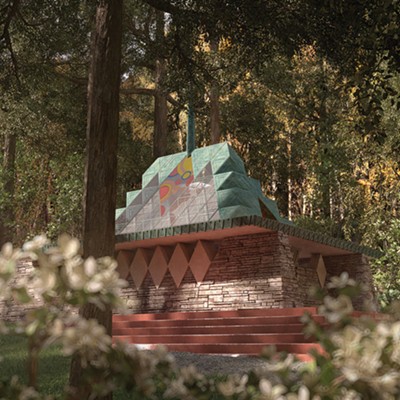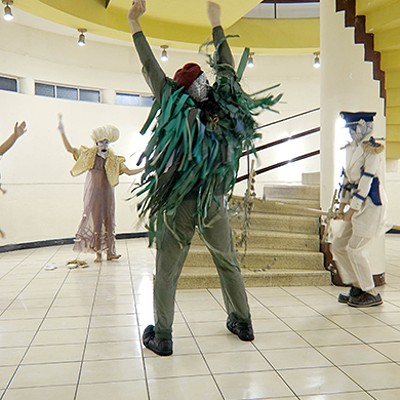Upon crossing Greensburg’s Main Street Bridge, flanked by Janet Zweig’s recently installed “Analog Scroll,” visitors are welcomed to the Westmoreland Museum of American Art by a beautiful grid of 440 shimmering stainless steel plates. The grid reflects sunlight and shadows of the landscape, creating a pixelated dance with the wind. Commissioned in 2015 by the Westmoreland Society, “Windframe,” by Tim Prentice, is a kinetic sculpture that inspired the museum’s current exhibition, The Art of Movement: Alexander Calder, George Rickey & Tim Prentice.
Logically, the first of the exhibition’s three groupings features the colorful and playful works of the pioneer who launched kinetic art in America, Alexander Calder. Calder trained as a mechanical engineer before pursuing painting; in 1930, he created his first abstract kinetic sculpture, which Marcel Duchamp later termed mobile.
Only one Calder mobile is on display, “Spring Blossoms” (1965), comprising nine red and yellow “petals” hung on red wire and delicately counterbalanced by a black blade. However, the visitor’s eye may be quickly drawn to the four vibrant Calder paintings below. Each blossoms with red, yellow and blue spheres or swirls, black spirals that seem to tendril across the frame. This is a garden of organic shapes that illuminate the artist’s fascination with composing motion.
Where Calder emphasized the gestural curves found in nature, George Rickey simplified his structures into linear forms, or what he called “blades,” which slice through space when propelled by wind. Like Calder, Rickey began his career as a mechanical engineer and studied painting, but at the age of 43, he shifted his focus to sculpture. “I want to make simple declaratory statements in a visual language I can control,” wrote Rickey in the essay “The Métier.”
He clearly articulates this brilliant visual language in the 15 pieces selected for exhibition. Drawings, prints and paintings fittingly complement the stunning sculptures that serve as touchpoints over his five-decade career. There is “Wave II” (1956), formed of eight stainless steel, aeronautical-shaped blades that tip like weights over a wooden cruciform base. A trio of sculptures from the 1990s exemplifies a fluency in both linear and circular structures. Lastly there is “Unstable Cube VI” (1971), which literally stands out; six sides of a cube ever-so-slightly open and close like ventricles pulsed by a current of air. Here the dance of movement is more akin to Japanese Butoh, where one must wait patiently in mindful repose.
The square pattern found in “Unstable Cube VI” serves as a perfect visual and physical segue into the most vast and magical part of the gallery, where more than two dozen works by Tim Prentice dominate. Continuing in the tradition of Calder and the late Rickey, whom he calls “heroes,” the Connecticut-based Prentice is also a masterful technician of wind velocity and gravity, melding the principles of his predecessors into a unique and sinuous vocabulary of his own. Where the two elders brought engineering know-how to the field of sculpture, Prentice brings a decisively architectural perspective from practicing in the field for more than a decade before, like Rickey, turning to sculpture at the age of 43.
With Prentice’s work there is much to take in — from the whimsical metal frogs and insects on pedestals to the whirling swoops of color and shape spinning upon the wall. But the essence of this collection hangs in space above the gallery and by a large bank of windows. A series of delicate Lexan, steel and aluminum squares gently sway on a varying latticework of wire, each pane reflecting light from the outside world. A striking departure from the grid of squares is “The Fuzz” (2005), a lush pin-like steel curtain that spins slowly in front of the windows. These works can be experienced and examined up close — activated with one’s breath — as well as pondered at a distance. Visitors are invited to lay upon a patch of artificial turf beneath “Scattery Cloud” (2017) to watch a constellation of Lexan and metal squares subtly do-si-do in space.
On the first floor, an exciting selection of participatory and kinetic art by members of the Pittsburgh Society of Sculptors further enriches one’s visit. Juried by Barbara Jones, chief curator of The Westmoreland, and artist Kathleen Dlugos, Handle With Care consists of 20 works that dismantle the fourth wall of the passive museum experience. An excellent exhibition for the visually impaired, it includes several tactile works, including “Tongues Out” (2017), by Gadi Lesham. Guests are encouraged to touch three highly expressive ceramic faces, each with its tongue protruding. One tongue is covered in velvet, one in spikes, and the last looks like a painful field of pustules. In contrast, Ashley Hickey Flavin’s “Emerging” appears as a fingerprint from nature, the wood rings of a plank of pine outlined with moss and lichen that one may touch gently, as if reading the palm of a fallen tree.



















